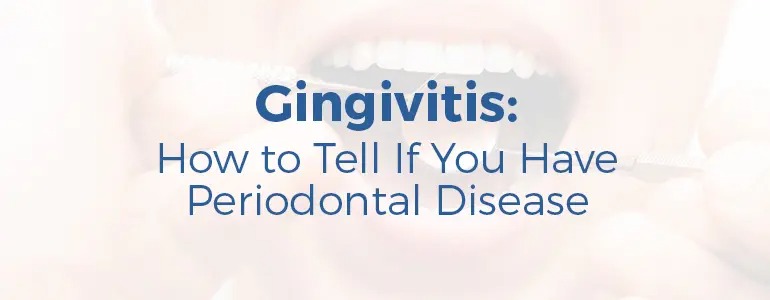
Your health is important to you. Beyond aesthetics, to keep yourself healthy, you also want to prevent bacteria and toxins from invading your body. Because your mouth is a magnet for bacteria, a lack of oral hygiene and preventive care can lead to gum disease, also known as gingivitis or periodontal disease.
Periodontal disease (or periodontitis) is common in the U.S. and affects around 47.2 percent of Americans 30 years old or older, according to the American Dental Association (ADA). It’s also a significant reason why adults lose their teeth.
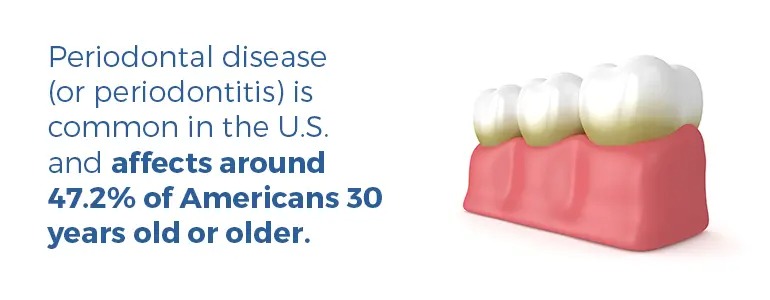
By educating yourself about gum disease and its symptoms, you’ll know if or when you’re developing a problem that requires gingivitis treatment. Once you’re knowledgeable about gum disease, you’ll also know how to prevent gingivitis in the first place or catch it early enough to reverse it.
The longer you allow tartar and plaque to sit on your teeth, the more trouble they can cause for your teeth and gums. The bacteria can lead to gum inflammation and a dental condition known as gingivitis. When your gingiva becomes inflamed, you experience sore, bleeding or swollen gums.
Gingivitis is a mild stage of gum disease that can be reversed by brushing and flossing your teeth more thoroughly and having a professional cleaning performed by a dental hygienist. With gingivitis, you don’t have any loss of tissue or bone responsible for holding your teeth in place.
If you leave gingivitis untreated, however, it can advance to a more severe stage: periodontal disease or, even worse, periodontitis. With periodontal disease, your gums swell and the inflammation may become so severe it causes you to lose the tooth-holding tissue, potentially resulting in the loss of one or more of your teeth.
The sticky film of bacteria and plaque sticks to your teeth and is what causes this inflammation. Brushing your teeth two times a day (morning and night) and cleaning in between your teeth with floss removes this plaque. If you don’t remove this plaque, your gums may separate from your teeth and form pockets that collect bacteria. The following factors may increase your risk of developing gum disease and start this vicious cycle:
Although the sound of this may scare you, gingivitis is still in the reversible stage of gum disease. At this point, it may just take a simple trip to the dentist to have your teeth professionally cleaned. If you follow up with, and then commit to, proper oral hygiene, you’ll probably be just fine.
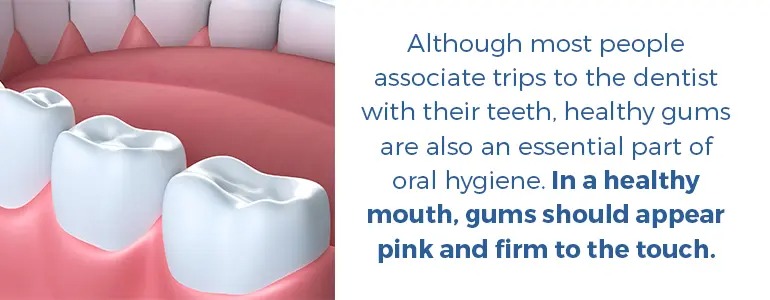
Although most people associate trips to the dentist with their teeth, healthy gums are also an essential part of oral hygiene. In a healthy mouth, gums should appear pink and firm to the touch.
Puffiness and redness indicate the early signs of gingivitis, as does bleeding during brushing and flossing. If you are asking yourself, “Why are my gums inflamed?” then it’s likely you have gum disease. Keep in mind that these symptoms do not usually cause pain — if you observe bleeding following brushing and flossing, gingivitis is most likely the culprit.

There are other ways to tell if you have gingivitis, such as receding gums and bad breath. If you notice any of these symptoms, it’s time for an oral cleaning and checkup.
Swollen gums are common and can occur for several reasons, including the ones listed below. You should contact your dentist if the swelling lasts more than several days. The dentist will rule out other causes of inflamed gums, such as:
And, of course, if you’ve been brushing your teeth and flossing as you should, the dentist will look at the possibility of gingivitis.
You should be concerned with bleeding gums, too — even if you have regular cleanings. When gums bleed, it’s usually a sign of gingivitis or periodontal disease.
When thinking about their dental health, most people focus on their teeth and preventing cavities. However, your gums are just as important and play a significant role in your oral health. Not only that, but your overall health, too. In many cases, bleeding, swollen or sore gums are a sign of gum disease. Ask yourself some questions to check how healthy your gums are:
Contact the dentist to have a periodontal evaluation performed if you answered “yes” to any of these questions. Even if your teeth are brilliant white and cavity-free, it doesn’t mean you can’t get gum disease. But many people don’t realize they have it because it typically doesn’t cause pain.
Other Indications of Gingivitis
Other things indicate gingivitis, too, such as bad breath and receding gums. If you experience either of these, you should set up an appointment with the dentist for a checkup, oral cleaning and other preventive care.
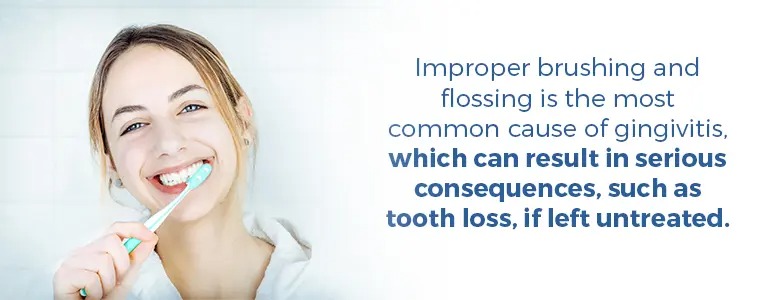
Plaque leads to gingivitis in a number of ways:
Several factors can play a role in your developing gum disease. These include:
Poor oral hygiene: A primary cause of gingivitis is poor oral hygiene. In fact, it’s the leading cause of periodontal disease, since it allows plaque formation on your teeth and causes inflammation of your gum tissues. After a person eats, a thin layer of plaque and bacteria form in the mouth. Improper brushing and flossing is the most common cause of gingivitis, which can result in serious consequences, such as tooth loss, if left untreated.
Although brushing removes most of the plaque, tiny bits of bacteria left in between and on the teeth harden into tartar. This is why flossing daily is essential. Tartar protects the bacteria from brushing and flossing and the bacteria can irritate the gums and causes gingivitis. Unfortunately, at-home brushing and flossing cannot remove the plaque and bacteria once they have hardened into tartar.
Changes in hormones: These changes may happen during pregnancy, puberty, a menstrual cycle or menopause. You may have more sensitive gingiva, increasing your risk of inflammation.
Certain diseases: Diseases like diabetes, cancer or HIV may make you more susceptible to gingivitis.
Medications: If you’re taking certain oral medications, it can affect your oral health. Some medications reduce your saliva flow, while others may cause abnormal gum tissue growth.
Smoking: Smoking regularly can contribute to gingivitis.
Age: Your risk of gingivitis goes up as you get older.
Genetics: If you have family members who have or had gingivitis, you may have a higher chance of getting it, too. It’s believed that there’s a certain type of bacteria you acquire during your early life.
Gingivitis is contagious since it’s a type of gum bacterial infection. Therefore, you can spread it through saliva exchange when sharing cups, silverware, or through kissing.
Gingivitis is a direct cause of tooth decay problems potentially leading to the need for dental surgery such as root canal. Because the dentist can remove hardened-on tartar during a regular cleaning, you can protect yourself from more serious periodontal care simply by scheduling cleanings at six-month intervals.
Sadly, gingivitis consequences don’t end with just a simple cavity. Periodontitis spreads to your tissue and bone under your teeth’s visible layer, causing tooth loss. Periodontitis may also lead to premature birth weight, heart attack and more. In fact, it’s linked to systemic diseases like:
Periodontitis bacteria, according to research, may even extend through your gum tissue and travel into your bloodstream and affect your lungs, heart and other organs. But to confirm this link, researchers need to collect more evidence.
Necrotizing ulcerative gingivitis (NUG), also called trench mouth, is a severe type of gingivitis-causing infected, painful and bleeding ulcerations and gums. Trench mouth is not common today in the U.S., but it does still linger in developing countries due to poor living conditions and nutrition.
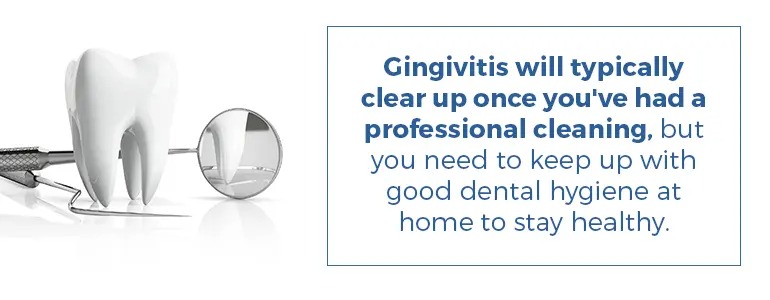
Quickly acting can reverse gingivitis symptoms and keep it from progressing to more severe periodontal disease and tooth loss. You can adopt a daily ritual of proper dental care and quit using tobacco products, too. Professional gingivitis care includes:
By staying consistent with your dental hygiene, your gums should return to being healthy and pink within a couple of weeks.
Once you detect gum tissue inflammation or gingivitis, it’s essential that you begin treatment right away to keep the infection from becoming severe and spreading. You may reverse the beginning stages of gingivitis by learning how to treat gingivitis at home and implementing the following action steps:
Use antibacterial toothpaste and mouthwash: Antibacterial toothpaste helps fight plaque even after you’ve finished your dental hygiene routine. Get the bacteria and plaque out of those hard-to-reach places with antibacterial mouthwash.
Brush your teeth properly: Ensure you’re brushing your teeth for at least two minutes each session. You may want to use an electric toothbrush to ensure you’re cleaning your teeth thoroughly.
Try Home Remedies: A few home remedies you can try include:
Eat a healthy diet: When and what you eat is a huge part of keeping your gums and teeth healthy. If you’re eating foods high in simple carbohydrates and sugar, it may increase your risk of gum and tooth issues. This is due to sugar creating an environment ideal for the formation of plaque.
Be sure you’re eating a diet rich in essential nutrients, like vegetables, and that’s low in sugar. This isn’t to say you have to cut sweet foods out of your diet completely. You just need to eat them moderately, and if you do eat a food high in sugar, be sure to brush afterwards to ensure it doesn’t stick to your teeth.
Be mindful of the products you use: Numerous products, such as mouthwashes containing alcohol or chlorhexidine or toothpaste with hydrogen peroxide, are available for keeping bacterial infections away. Hydrogen peroxide is effective in getting rid of gingivitis at the first sign of it.
Practice preventive care: Be proactive about preventive oral care. Brush your teeth two times daily (morning and night). The ADA recommends using a soft-bristled or extra-soft bristled toothbrush. You need to floss your teeth daily, too.
Always be a step ahead of gingivitis by always practicing good dental health, brushing and flossing every day and setting those preventive care appointments.
At your appointment, review your brushing and flossing habits with the dentist. Ask for recommendations on toothpaste, brush types and mouthwashes. Schedule regular cleanings at six-month intervals to remove hardened-on tartar and don’t forget that certain activities — such as quitting smoking and eating a diet packed with healthy nutrients — will benefit your health in more ways than one.
Remember: you may already have gingivitis and not even know it, since it may be painless. Because of this, it’s imperative you schedule those dental checkups so the dentist can keep an eye on it.
And, in all situations, preventive care is best. Book your preventative dental care appointment at AZ Family Dental today by calling (623) 939-6574 or completing our online form.
Dr. Matt Parker D.M.D is a member of the American Dental Association, Arizona Dental Association, Academy of General Dentistry, American Association of Endodontists, the Academy of LDS Dentists and a member and fellow at the International Congress of Oral Implantologists.